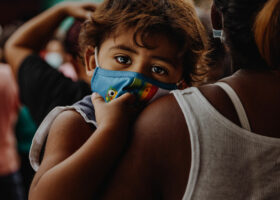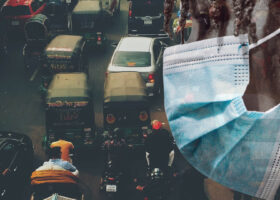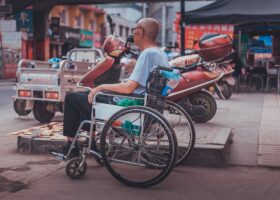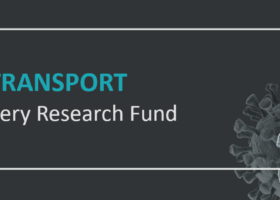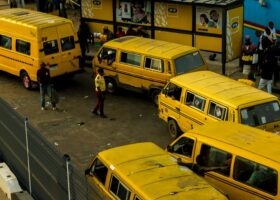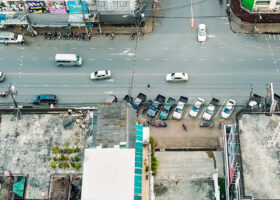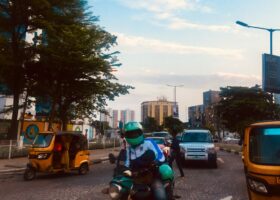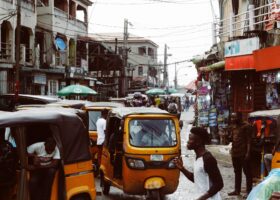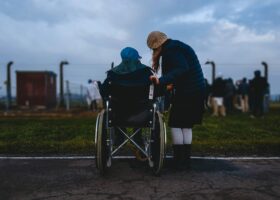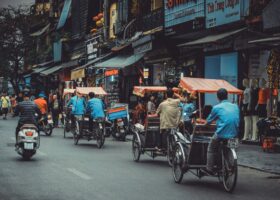Overview
Elderly and physically challenged people have different travel needs and challenges. Transport infrastructure and services in all Low-Income Countries (LICs) are not easily accessible for elderly and physically challenged people. Added to these problems, the Novel Coronavirus Disease 2019 (COVID-19) pandemic has had a profound impact on peoples’ mobility in almost every country around the world (i.e. both in LICs and elsewhere), changing activity patterns and travel behaviour.
This research provides a detailed understanding about the mobility of elderly and physically challenged people in LICs during COVID-19; particularly as to whether there are any significant changes due to COVID-19 and any major constraints or issues related to their travel. Household surveys of 1,669 elderly and physically challenged people were conducted in eight case study cities in Bangladesh, Pakistan, Tanzania and Zambia during November 2020.
It was found that public transport services in the case study cities are very poor and lack appropriate infrastructure to facilitate mobility of elderly and physically challenged people even before COVID-19 pandemic. Therefore, elderly and physically challenged people in LICs often face many difficulties for travel. Moreover, their travel in all the cities has changed due to COVID-19 and they face even more problems that previously. The most significant changes and problems were found to be: reduction of travel; changed travel mode such as switching from public transport to private and non-motorised modes; increased travel cost and decreased income; and additional travel problems such as the need to maintain physical distancing and the need to use masks and hand sanitizers.
Based on the results of this research, the suggested policy options are to: improve infrastructure for nonmotorised modes and promote sustainable modes of the city; provide transport infrastructure and services that are accessible for elderly and physically challenged people; subsidise the travel costs of elderly and physically challenged people particularly during COVID-19; plan and regulate informal modes or para-transits; increase the number of public transport vehicles and routes; and generate public awareness concerning health guidelines, followed by strong enforcement of physical distancing, wearing face masks, and using sanitisation during travel. The findings will be helpful for city authorities in making appropriate policy decisions, formulating strategies and investment plans related to transport, as well as in supporting COVID-19 responses and recovery plans.
Publications with the same themes
Publications with the same study countries
Related news & events
News
Blog
Blog
News
News
News
Blog
News
Blog
Blog
Blog
PDF content (text-only)
1 A policy brief calling for improved mobility for elderly and physically challenged people How has the mobility of vulnerable people been impacted by COVID-19? June 2021 HVT029.L1M086 – Prof. Dr M. Shafiq-Ur Rahman This research was funded by UKAID through the UK Foreign, Commonwealth & Development Office under the High Volume Transport Applied Research Programme, managed by IMC Worldwide. The views expressed in this Policy Brief are those of the authors and do not necessarily reflect the UK government’s official policies, nor those of any individuals and organisations referred to in this policy evidence report. IMC Worldwide Ltd, the HVT Programme and the UK government shall not assume any responsibility for the results of works based on the use of this Policy Brief. Users accept this publication is a guidance document only. Users accept that they need to take their own technical and legal advice before issuing Agreements, Terms and Conditions and other legally binding documentation related to implementing any recommendations. The data collection, consultation and other research processes used to create this Policy Brief have been subject to the necessary data protection regulations and requirements operating in the relevant countries where the research was conducted. All due diligence has been undertaken to ensure that data sources and statistics quoted have been appropriately aggregated so as to remain anonymous and not to identify any individual. Personal data has only been processed or used for specific and legitimate purposes. Reference No. HVT029.L1M086 Lead Organisation/ Consultant Prof. Dr. M. Shafiq-Ur Rahman Partner Organisation(s) Title How has the mobility of vulnerable people been impacted by COVID-19? Type of document Policy Brief Theme Gender, inclusion, vulnerable groups Sub-theme Policy and Regulation Author(s) M. Shafiq-Ur Rahman Lead contact Prof. Dr M. Shafiq-Ur Rahman Geographical Location(s) Bangladesh, Pakistan, Tanzania, Zambia Keywords Mobility, disabled, elderly, travel, trip, transport, COVID-19, policy, Africa, Asia Funding UKAid, FCDO Cover Photo Credit: M. Shafiq-Ur Rahman / Mustafizur Rahman i CONTENTS Policy Overview 1 1. Informing policy 2 1.1 What we did 2 1.2 What we found 2 1.3 Why is it important? 3 1.4 Policy recommendations 4 1.5 Follow-up research uptake 4 APPENDICES Appendix A: Summary research 5 Appendix B: Policy actors and stakeholders 6 ACRONYMS COVID-19 Novel Coronavirus Disease 2019 LIC Low-income country NGO Non-governmental organisations SDG Sustainable Development Goals 1 POLICY BRIEF: How has the mobility of vulnerable people been impacted by COVID-19? POLICY OVERVIEW Elderly and physically challenged people have different travel needs and challenges. Transport infrastructure and services in all Low-Income Countries (LICs) are not easily accessible for elderly and physically challenged people. Added to these problems, the Novel Coronavirus Disease 2019 (COVID-19) pandemic has had a profound impact on peoples’ mobility in almost every country around the world (i.e. both in LICs and elsewhere), changing activity patterns and travel behaviour. This research provides a detailed understanding about the mobility of elderly and physically challenged people in LICs during COVID-19; particularly as to whether there are any significant changes due to COVID-19 and any major constraints or issues related to their travel. Household surveys of 1,669 elderly and physically challenged people were conducted in eight case study cities in Bangladesh, Pakistan, Tanzania and Zambia during November 2020. It was found that public transport services in the case study cities are very poor and lack appropriate infrastructure to facilitate mobility of elderly and physically challenged people even before COVID-19 pandemic. Therefore, elderly and physically challenged people in LICs often face many difficulties for travel. Moreover, their travel in all the cities has changed due to COVID-19 and they face even more problems that previously. The most significant changes and problems were found to be: reduction of travel; changed travel mode such as switching from public transport to private and non-motorised modes; increased travel cost and decreased income; and additional travel problems such as the need to maintain physical distancing and the need to use masks and hand sanitizers. Based on the results of this research, the suggested policy options are to: improve infrastructure for nonmotorised modes and promote sustainable modes of the city; provide transport infrastructure and services that are accessible for elderly and physically challenged people; subsidise the travel costs of elderly and physically challenged people particularly during COVID-19; plan and regulate informal modes or para-transits; increase the number of public transport vehicles and routes; and generate public awareness concerning health guidelines, followed by strong enforcement of physical distancing, wearing face masks, and using sanitisation during travel. The findings will be helpful for city authorities in making appropriate policy decisions, formulating strategies and investment plans related to transport, as well as in supporting COVID-19 responses and recovery plans. 2 POLICY BRIEF: How has the mobility of vulnerable people been impacted by COVID-19? 1. Informing policy A significant share of population (at least 10%) in all low-income countries (LICs) are elderly or physically challenged people. Transport and mobility options for those who need assistance are very limited in the LICs. Public transport infrastructure (buses and terminals) and services are not easily accessible for physically challenged and elderly people. This is particularly problematic since they rely more than other social groups on public transport. Furthermore, since elderly and physically challenged people have different travel needs the issue of appropriate public transport for these groups requires detailed investigation to formulate suitable policy directions. The Novel Coronavirus Disease 2019 (COVID-19) pandemic has had a profound impact on peoples’ mobility in almost every country around the world, changing activity patterns and travel behaviour. A range of studies from different countries (mostly western or non-LIC countries) focusing on the impacts of COVID-19 on mobility have demonstrated that different sociodemographic groups have changed travel behaviour in a variety of ways in response to COVID-19. In particular, elderly and physically challenged people are facing more difficulties than the young and non-disabled people for travel during the COVID-19 pandemic. The main purpose of this research is to understand the mobility of elderly and physically challenged people in LICs during COVID-19; particularly, to investigate if there are any significant changes due to COVID-19 and whether there are major constraints or issues related to their travel. The research contributes to the knowledge base and raises a variety of issues concerning governance and policy. This evidence-based knowledge will be helpful for policymakers, city authorities, Non-Government Organizations (NGOs) and development agencies in identifying priority actions required for immediate responses and recovery, and in providing guidelines related to transport and mobility. This research has a direct link to the Sustainable Development Goals (SDGs): Goal 10 (reducing inequalities) and Goal 11 (sustainable cities and communities). 1.1 What we did The study was designed with case studies of eight cities of four LICs from Asia and Africa: Dhaka and Khulna in Bangladesh; Karachi and Lahore in Pakistan; Dar-es-Salaam and Zanzibar in Tanzania; and Lusaka and Kitwe in Zambia. A total of 1,669 interviewees (around 200 elderly and disabled persons from each of the cities) were selected randomly from the households. A stratified sampling technique (considering gender, social class or economic condition, spatial distribution, disability type) was followed so that the samples were selected from different socio-economic classes and were spatially distributed across each city. Face-to-face household interviews were conducted during November 2020 using a pre-determined questionnaire, maintaining proper physical distance and health guidelines. Questions were asked about: preference for mode choice and actual mode choice; travel costs; social distancing and personal safety; and problems and suggestions for improvement of mobility. These questions were asked about the periods both before and during (lockdown and post-lockdown) the COVID-19 pandemic. The household survey provided both quantitative and qualitative data concerning the respondents. 1.2 What we found The study provides an excellent opportunity to compare and contrast travel behaviour and practice for elderly and physically challenged people of different cultures, from different geographic locations with diverse policies during COVID-19 and before COVID-19. It was found that public transport services in Bangladesh, Pakistan, Tanzania, and Zambia are very poor and lack appropriate infrastructure to facilitate mobility of elderly and physically challenged people even before COVID-19 pandemic. The travel of elderly and physically challenged people in all the cities changed due to COVID-19. The major changes were: • reduction of travel (avoiding travel or reduced frequency of trips) during lockdown and post-lockdown; • changed travel mode (switch from public transport or shared vehicles to private and non-motorised modes), as seen in Appendix A; • increased travel cost and decreased income (see Appendix A); 3 POLICY BRIEF: How has the mobility of vulnerable people been impacted by COVID-19? • additional travel problems due to COVID-19; • need to maintain physical distancing, and to use masks and hand sanitizers due to COVID-19. The impacts of COVID-19 during lockdown periods were greater than the impacts during post-lockdown periods. During the lockdown, the amount of public transport was low and as a result those who wanted to go out for work or medical supplies had to wait a longer time or use private vehicles. For those who travelled during the lockdown, their frequency of travel was much less compared with before the COVID-19 situation. However, the effects were not same in the four countries as the level of lockdown was different. Most of the respondents in all the cities except Lusaka and Kitwe avoided travel and did not make any trips during lockdown. The travel frequency of many respondents in all the cities except Lusaka and Kitwe before the pandemic was 4-5 trips or 5+ trips per week, which decreased to once or 2-3 trips per week during lockdown. During post-lockdown, the travel frequency of the respondents increased compared to during lockdown but decreased compared to the period before COVID-19. For example, the frequency of travel was once or 2-3 trips per week for a large portion of the respondents in all the cities during post-lockdown. The main purposes for trips during lockdown and post-lockdown were purchasing grocery (or shopping more generally), work, and doctor visits. During lockdown social and recreation trips were completely avoided. During post-lockdown social trips increased to around 10% of all trips, though recreation trips are less, compared with before COVID-19. During lockdown, the usage of public transport reduced in comparison to before COVID-19, while active modes and private modes increased. Except in Dhaka, Dar-es-Salaam and Zanzibar, the usage of paratransit modes during lockdown increased in other cities. Paratransit modes in many cities provided individual taxitype services with higher fares both during lockdown and post-lockdown periods. During post-lockdown, a slight decrease in usage of public transport and increase in private vehicles was observed in all the cities. A significant reduction in paratransit, but increase in private vehicles, was observed after lockdown in Lusaka and Kitwe in comparison to before COVID-19. Due to COVID-19 more travel problems are added for elderly and physically challenged people. Whilst the travel problems during lockdown and post-lockdown were similar, there were a few additional problems during lockdown due to travel restrictions and regulations imposed whilst travelling. The added problems during lockdown were: • limited availability of public transport vehicles, so longer waiting times; • reduced travel due to imposed restrictions on travel and movement; • more being forced to walk due to the unavailability public transport or limited services. The travel problems due to COVID-19 during post-lockdown are: • reduced travel or fear of being infected by COVID-19 during movements out of home; • increased travel cost; • reduced seating capacity in bus for maintaining physical distancing; • wearing face mask is uncomfortable for breathing; • lack of compliance for maintaining physical distancing and wearing face mask or using sanitisation. 1.3 Why is it important? The mobility of elderly and physically challenged people is very important for improving their access to services. Elderly and physically challenged people in LICs face many difficulties for travel. More problems are added for their travel due to COVID-19. The results of this research will be helpful for city authorities and governments in making appropriate policy decisions, formulating strategies and investment plans related to transport, as well as in supporting COVID-19 response and recovery plans. 4 POLICY BRIEF: How has the mobility of vulnerable people been impacted by COVID-19? 1.4 Policy recommendations The findings of the research will have impacts on the following policy themes: • integrated multimodal public transport, particularly improving infrastructure for non-motorised modes (e.g. bicycling and pedestrian facilities) of the city; • provision of transport infrastructure and services that are accessible for elderly and physically challenged people. Pedestrian paths, stations, road crossings and public transport vehicles should be designed and provided in such a way that the elderly and physically challenged people can use them comfortably and conveniently. Other amenities and services such as shops, parks and recreation facilities need to be available within a convenient walking distance (or in the neighbourhood) and accessible/usable by them; • increase the number of public transport vehicles for providing more frequent public transport services and expanding the route network coverage; • subsidies for reducing the travel costs (ticket prices) of elderly and physically challenged people until the COVID-19 pandemic is finally resolved; • planning and regulation of informal modes and para-transit in the LICs; • awareness generation amongst people for maintaining health guidelines (e.g. maintaining physical distancing, wearing face mask and using sanitisation) along with strong enforcement by the respective authorities and agencies. 1.5 Follow-up research uptake The new knowledge derived from this research will be transferred among the practitioners of different agencies. A conference presentation to inform and disseminate the findings among the relevant researchers and practitioners of urban/ transport planning will be held by August 2021. Targeted meetings with the city authorities and the agencies responsible for transport in respective cities (e.g. Dhaka, Khulna, Karachi, Lahore, Dar-es-Salaam, Zanzibar, Lusaka, Kitwe) will be organised by August 2021 to share the key findings and to handover the policy brief to them. The policy actors and stakeholders are shown in Appendix B. A training workshop or webinar involving policymakers and government officials (e.g. civil servants) will be conducted by September 2021. A journal publication for sharing the findings among academics and researchers will be published by October 2021. 5 POLICY BRIEF: How has the mobility of vulnerable people been impacted by COVID-19? APPENDIX A: SUMMARY RESEARCH 0 20 40 60 80 100 120 % of Respondents Increased travel cost and decreased income due to COVID-19 Increased travel cost Decreased household income 0 10 20 30 40 50 60 70 % of Respondents Changed travel and face additional problems due to COVID-19 Changes in travel & mobility Aditional travel problems 6 POLICY BRIEF: How has the mobility of vulnerable people been impacted by COVID-19? APPENDIX B: POLICY ACTORS AND STAKEHOLDERS Potential stakeholders of this research are: city authorities, with responsibility for both transport and other sectors; NGOs and development agencies; and transport service providers. The table below shows examples of the stakeholders who will be targeted. Institution Stakeholder Role Transport authority of the city e.g. Dhaka Transport Coordination Authority (DTCA) Transport Planner Strategic transport planning of the authority/city, preparing transport management plan Local government or municipality e.g. Khulna City Corporation (KCC), Zanzibar Unguja City Chief Town Planner Preparing urban/transport plan of the city, providing open space or recreation facilities and transport infrastructure, managing and planning non-motorised modes, imposing parking fees and charges City Development Authority e.g. Karachi City Development Authority, Rajdhani Unnayan Kartripokkho (RAJUK) in Dhaka, Kitwe Development Authority Town Planner Strategic development of the city, managing growth of the city, integrating land use and transport plan NGO or Development Agency e.g. National Grassroot Disability Organisation (NGDO), Work for Better Bangladesh Trust (WBBT), Good Samaritan in Tanzania Director or Researcher Advocacy and planning, awareness building, public involvement in implementing different policy actions Relevant ministry e.g. Ministry of Transport, Ministry of Social Welfare Deputy Secretary or the focal person of respective ministry Implementing relevant agenda of the government, developing policy guidelines and framework Transport Service Providers e.g. public transport company President of owner’s association or CEO of the company Strategic decision making in operation, route network planning of transport services, and pricing of tickets University or research institution e.g. Bangladesh University of Engineering & Technology (BUET), University of Engineering & Technology Lahore (UETL), University of Zambia Professor or Lecturer of Urban Planning or Geography or Civil Engineering Teaching and research on relevant subjects Prof. Dr. M. Shafiq-Ur Rahman Department of Urban & Regional Planning (URP) Jahangirnagar University Savar Dhaka, 1342 Bangladesh Tel: (+88) 01711398754 Email: shafiq_urp@yahoo.com Web: www.juniv.edu/teachers/shafiq_urp




